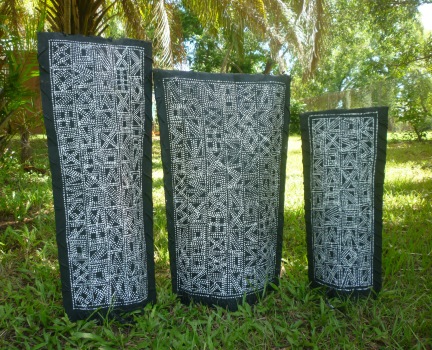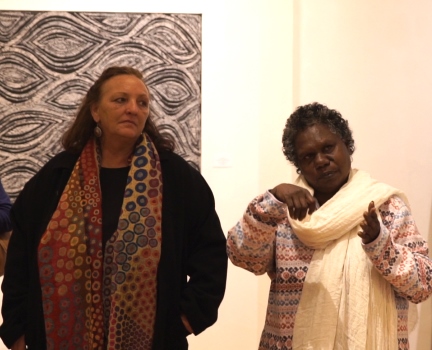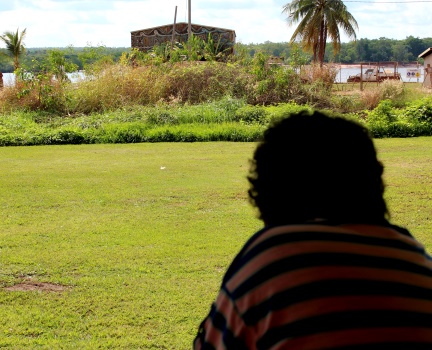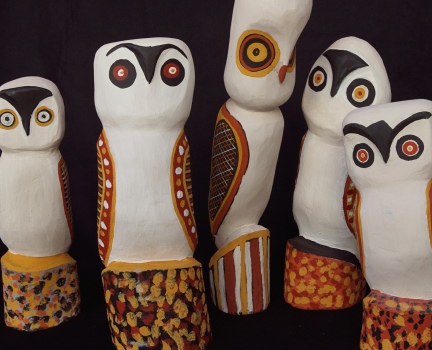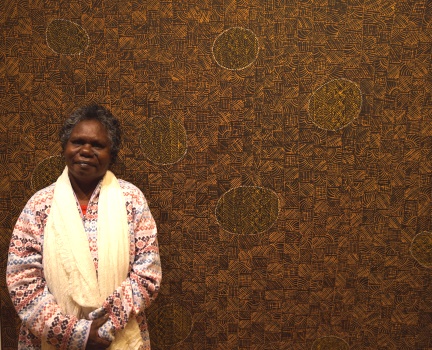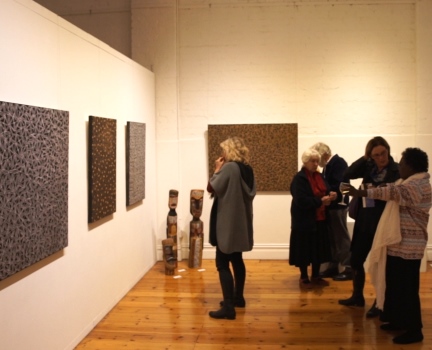Tiwi Design Art Centre: A Peaceful Place For Art
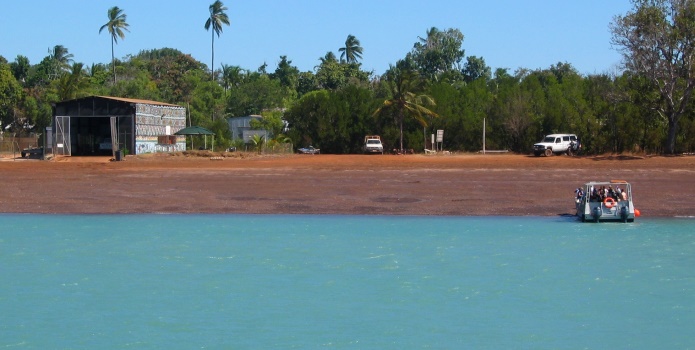
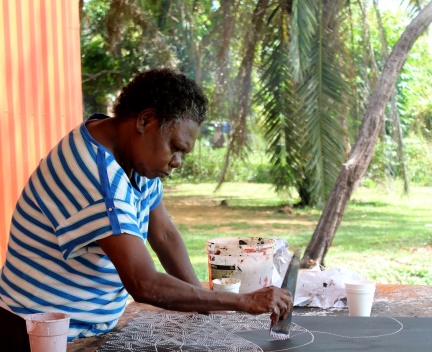
By: David Wroth, Japingka Gallery, 2016
Dianne is Studio Co-ordinator for Tiwi Design Art Centre on Bathurst in the Tiwi Islands. In this article she talks about the diversity of her role. She reflects on cultural change within the Arts Centre, the No Humbug rule, wish lists, Work for the Dole and sister girls.
Where is the Tiwi Islands and how do you get there?
The Tiwi Islands are about 100 km north of Darwin. There’s two ways that you can get there. One is to fly on a small aircraft, the other a ferry service that mostly runs on Thursdays, Fridays and Sundays.
Can you describe what it’s like at the Art Center?
It’s quite a large Art Center. We’ve got three separate buildings. The pottery, the wood shed and the gallery space, selling space with an artists space out the back overlooking the waters of the Apsley Strait. This includes a print-making studio as well where we do fabric printing and t-shirts.
How many artists are there?
I don’t think there is a Tiwi person who isn’t an artist, in as much as they all carry the culture and the stories. Probably half of the 2,500 people carve and paint and do the work.
How many use the facilities of the Art Center, the studios?
That can change from day to day, depending on what’s happening with family business. We’ve got probably a core of about 20 artist who are moving through on a daily basis. About 60 are coming occasionally, and come and sit with other family members and will do something while they’re there.
Sometimes they are just wanting a days respite from family. So they’ll come and sit and make an artwork or tell stories. It’s not only a place for art. It’s a place where they can come together and speak with each other without the pressure of family. There’s a “No Humbug” rule in the building. This means that the others can relax and enjoy doing their work without the interruptions and the arguments coming through.
It’s a peaceful place.
Yes, it is. We’ve created a really lovely, peaceful space where people can be really contemplative of their artwork and in connection with their ancestral stories as well. I’ve seen the development of their artwork and their own connection with the artwork again rather than it being for the marketplace. That is, I think, a really important part of being an artist is really being connected with your work.
Can you tell me about the sorts of things you do in your role?
It is interesting because often I knock off and then I go home and do my work. It’s so diverse. Somebody will come in and they haven’t been and picked up their hearing aid, so it’ll be, “Let’ go up to the clinic.” “Auntie such-and-such needs picking up,” or “Can you do some money transfers for me?” We do a lot of that type of work as well. People will come in and do their banking. I’ll help them with their banking or help them transfer money from this auntie to that auntie. Sometimes we go up to the shop and buy some groceries.
So, there’s community work and there’s art-related work.
Yes. The community work seems to take up a lot more time than the art-related work. Not so much in painting or creating the art, but certainly in bringing a show together. We’ll have the idea then we don’t talk about it again. That’s already up and running, so then we’re, “Oh, Mum’s not here for damper, but we better go and get her.” It’s very family orientated. Family does come first which is the way it should be, really.
You’ve been there for seven years. What sort of changes have you noticed in the art, in the artists, in the Art Center?
When I arrived, people were painting more for the market. They had been driven towards a market view in doing their paintings. A lot of their artworks were hit and miss because of it. A lot of them were probably made quicker than they could’ve been. It showed in the artworks themselves. Now they’re re-establishing a connection with culture. It has made a large difference in how they approach their work. When we first arrived, they used to call them beer carvings; cut something really quickly so that they could have the money for the club and have a beer.
How did that change? How did you take it from that to a more connected painting? Was it something you did or the community together did?
There was a lot of humbug happening under the building. People were under stress. People ended up just wanting to quickly produce something and move back out again. There was a lot of argument and in-fighting amongst the different skin groups.
We put forward the idea that when we’re under this roof, we are one Tiwi family. That meant one skin group wasn’t dominating over another. We really made sure that that was so. Once everybody started to see that, “Oh, this is really lovely, to come down and there not be that humbug. It is really lovely to be reconnected with our work.” Then everybody just started to make sure that was how it became. They were standing up and going, “No, we don’t have humbugging in here anymore. You’ll have to go away.” Instead of me being the voice, they became the voices. Really, anything can only grow momentum if it’s coming from within the person themselves.
I had to step forward to begin with. Then they saw that things were working and were far more beneficial to everybody under the roof. They didn’t have to have those struggles between different skin groups of who was better than who, and who was carrying the better stories. We started to see ourselves as one Tiwi people. All of the relationships started changing under the roof. Now people say, “Have you got enough yellow ochre? I’ll do some for you.” They started to actually help each other even down to grinding ochres and things like that, instead of them just doing it for themselves.
Can you describe what role art plays in community there?
It’s funny. I think, from an outsider’s perspective, when somebody says art they see it as being a separate function. Whereas, within community, art isn’t something that is separate from the stories and from the ancestors. It’ a continuum and a connection with that story. So, there isn’t a separation between the artwork and the artists and the story. It’s really important that that connection is there. Each artwork is a connected continuum rather than an idea somebody’s had and splashed onto a canvas.
Do the Tiwi people like visitors to come?
When I first arrived at the Arts Center, although Tiwi people are really warm and very friendly, they’re also very shy. If visitors came to the Arts Center everybody would run down to the back. They had this little spot where they’d go and hide and all sit with each other and talk. Now, they’re walking out front. “Hello, where are you from?”
We started an art tour, for people to come in and interact and make art with the artists. To start with though, people were quite shy and a little bit scared. Now they’re just so lovely. They say, “Oh, we get to hear all these stories from all over the world.” They’re so interested in everybody else’s stories, in what they do in their lives and what happens in their country. The exchange is a two-way thing. A lot of the times they ask more questions then they have to realise, “Oh, they’ve come to listen to our culture,” but they’re so interested in what other people have to say as well.
Can you talk a little bit about what happens to the money when a painting is sold?
Just as culture doesn’t belong to any one person, it belongs to the whole family, so does money. If you catch a crab, the whole family eats it. You don’t go and sit on your own and eat it. When the money comes in, it will go to other family members that need something. Somebody might want a freezer or there’s a car. They buy a car and then the whole family use it. Everybody doesn’t have their own car. There’ll be one car and ten family members that use that one car. The money is shared just as much as their culture.
Can you explain the wishlist system?
When the big money comes in, everyone gets excited. It’d get dispersed but then there’d be nothing left. Within a day that money is gone. No matter how much there is, it’s gone within 24 hours because the more you’ve got, then the more it reaches out to the family.
I decided to create a wishlist for the artists of things that they might want, like a fridge or a freezer or a washing machine. It’s really basic stuff that they haven’t got in the homes. They would be going to the takeaway and buying instant food rather than cooking. Things like that. I got the wishlist together so that, first and foremost, we would buy the thing that was most important to the artist. Let’s buy the fridge this time before the money got dispersed. Now all of our artists have now got fridges and freezers and washing machines and TVs even. They’re getting right down the list. Not only that, once they’ve got a fridge then their son needs a fridge. Every family’s sharing it in that way.
What plans are there for the future at the Arts Centre?
We have Work for The Dole that is now up and running. People have to work 25 hours a week to get their welfare payment. The Arts Centre is now one of the providers of training for the Work for the Dole programs.
There’s about 300 people there that aren’t receiving any money at all because they’re younger people. The younger people are up in the night time and sleep late in the morning. They’re not getting to the programs that run first thing in the day. If you don’t turn up for three days in a row, it’s cut again for six weeks. Then you have to go back through the cycles again.
Another issue is that we have a really large population of sister-girls on the island. A sister-girl is the gay community, transgenders. When they go and sign up for their Work for the Dole program, they’ll be put into the men’s group. A lot of them haven’t actually got an income because of that.
Being a host provider, which I’ve now become, means that I can arrange work any time of the day or night. I’ve managed to get an afternoon program set up so that the young people can be engaged. We’ve got a music program that’s getting up and running and some afternoon after-school activities that the younger people will be running, ball skills. We’ve got a lot of great footballers come out of Tiwi and they all love football.
Our sister-girls have been invited to the Mardi Gras next year, so we’ve got someone coming to teach them how to sew costumes. It will be useful to just sew generally so they can make their own clothes. They might make some drag queen clothes. They can get some performances together to go out and perform and create an income for themselves.
We’re also putting in a commercial veggie garden with organic veggies and herbs. Women will come and they will do their Certificates in Horticulture 1, 2 and 3. The garden is right beside the Aged Care so we’ve just had the okay to cut a hole in the Aged Care fence. This means that the older folk can come through and sit in the garden. We want to make it a homey area so that families can come and talk with each other and interact.
We are also planning a cafe. We have a lot of visitors now, with the new tours and things. There’s nowhere in town to really sit down and have a cup of coffee or some lunch for our new visitors. At the Arts Centre we are right on the waterfront. We want to put a café in, which will then serve our fresh vegetables that we’re growing and also create some more employment. We’ve got a lot of exciting plans.
